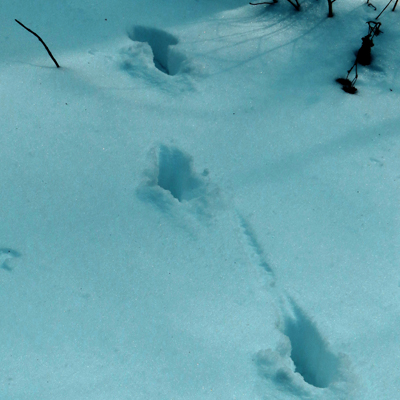Despite harsh conditions, the winter season is one of the best seasons for observing, studying, and photographing wildlife. During winter snowfalls, animal tracks in snow can provide valuable information about wildlife.
Tracks in snow can be used to identify species, and in some cases, even individuals. Footprints and other markings can provide valuable clues about movements, feeding behavior, population sizes, and other information.
Animal tracks in snow are studied by biologists, landowners, hunters, artists, outdoor photographers, amateur naturalists, and others.
Following snowfalls, animal tracks can be found in forests, meadows, and other habitats. Tracks are also found near lakes, rivers, creeks, and streams.
In North America, some of the most common tracks seen in fresh snow are left by deer, rabbits, squirrels, foxes, coyotes, raccoons, skunks, weasels, beavers, muskrats, otters, wild turkey, pheasant, songbirds, and many more.
In order to accurately interpret animals tracks in snow or ice, close attention must be paid to a variety of factors. Prior to field trips, it is usually important to gather information concerning recent weather conditions. Information concerning recent snow or other precipitation can provide a critical point of reference from which a timeline can be established.
During field trips, observers usually take note of current conditions such as time of day, temperature, wind speed and direction, direct sunlight, and additional precipitation. When a set of tracks is located, observations may include the size, shape and distance between footprints, general direction, unique features, freshness, and other attributes.
In addition to footprints, a trail may include other clues. Disturbed areas in snow may suggest a tail, underbelly, wings, antlers, or other parts. A close inspection of the trail may also reveal hair, feathers, debris, droppings, pawing, scrapes, kills, or other signs of animal activity.
After locating and studying tracks in snow, the following questions may be relevant:
What kinds of animals inhabit the area?
How many animals are present?
When and where do animals travel to find food or water?
How old are the tracks?
Were tracks made by resident wildlife or migrating animals?
Do tracks provide clues about an animal’s health?
Field Trip Equipment:
cold weather clothing, map, compass, gps, phone, spare batteries, camera, binoculars, spotting scope, notepad or sketch pad, pencil, ruler, plastic bags.
Where to Go
Animal tracks are often found in national, state, county, and city parks, wildlife refuges, national and state forests, private land tracts, and other areas.
